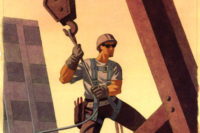Snapshot of the U.S. personal protective equipment market 2013
What is the most important trend in PPE distribution in the last five years?
 Undoubtedly the fact that almost everyone is now in the PPE distribution business. W.W. Grainger has vastly expanded its safety services, training, checklists, white papers, hotlines, etc. Fastenal, at one time a strictly or almost strictly an industrial fastener company, now markets vending machines of all sizes with all varieties of PPE. Staples, the office supply company, is now making a strategic penetration into the PPE market, including hiring safety sales specialists to advise and assist Staples' legion of field sales reps in making safety sales presentations to customers. Amazon is in the industrial supply business, including PPE. Home Depot is there too, with HD Supply.
Undoubtedly the fact that almost everyone is now in the PPE distribution business. W.W. Grainger has vastly expanded its safety services, training, checklists, white papers, hotlines, etc. Fastenal, at one time a strictly or almost strictly an industrial fastener company, now markets vending machines of all sizes with all varieties of PPE. Staples, the office supply company, is now making a strategic penetration into the PPE market, including hiring safety sales specialists to advise and assist Staples' legion of field sales reps in making safety sales presentations to customers. Amazon is in the industrial supply business, including PPE. Home Depot is there too, with HD Supply.
At the same time, and due in part to these multi-billion dollar businesses getting into PPE, we've seen the demise of many old-line safety supply houses. Family businesses that started around the birth of OSHA in 1970. 40+ years later the original owners are at, and have been at for some years, the retirement age and have cashed out because the next generation is not interesting in competing against the likes of Grainger, Airgas, Fastenal, MSC, HD Supply, Amazon, and just about every MRO industrial distributor in the U.S.
What are the main challenges for the PPE business in the future?
The value-add proposition. With so many distributors selling basically the same hard hats, safety glasses, gloves, respirators and hearing protectors, what differentiates one distributor from the next? Distributors have tried the strategy of selling safety-related services, but very few have prospered.
Another challenge comes from China. And other foreign countries in Asia selling PPE, often of dubious quality, here in the U.S. At very lowball prices. And unfortunately, when it comes to safety, a non-revenue generating aspect of businesses, many of those business managers will want to buy the least expensive PPE they can find just to stay out of OSHA's hair.
What’s the PPE competitive landscape?
The competitive landscape is rather brutal, I'd say. As mentioned, just about every distributor now sells PPE. Cheap imports just make a crowded competitive market more packed and noisy. Traditional safety distributors are fading away, as mentioned. The death of the Safety Equipment Distributors Association, made up mostly of those family-operated traditional houses, is a case in point of "creative destruction" at work in the PPE market. Only the strong survive. And to be sure, there are some old-line, strictly safety supply distributorships that are prospering nicely. Not surprisingly, they tend to be run by savvy, creative and aggressive leadership.
What’s driving PPE customer choice?
Branding has become quite significant in the U.S. PPE market. Many PPE vendors have taken to consumer-like image advertising and marketing campaigns. Consumer goods companies such as Harley-Davidson and John Deere, Dickies, Carhartt, Skechers footwear, to name a few, have either licensed their brands to PPE companies to enhance the image of commodity PPE, or have dived in and created safety divisions to market their own PPE. Consumer marketing strategies make sense for many types of PPE, such as hard hats and safety eyewear and footwear, because these items are in fact a form of personal clothing. So workers want to "look good, look cool," wearing their own style and identity of PPE.
Brand loyalty has long been a factor in the PPE market in the U.S. Many PPE buyers are safety managers who are conservative and risk-averse by nature. Their business is keeping being safe after all. So they tend to stick to the PPE buying sources they've used for years.
Another factor in favor of brand loyalty is the fact that in the U.S. sales relationships have long been an important factor between PPE sellers and buyers. Many buyers have known their safety sales reps for years, personal relationship bonds of confidence and trust have been formed, and buyers are very comfortable maintaining those relationships.
Along the same lines, you see many PPE distributors and manufacturers making strategic decisions to position themselves as safety "thought leaders" through the hiring of safety professionals with credentials to serve as toll-free hotline advisors to customers, authoring authoritative white papers on safety subjects, airing webinars with safety subject matter experts, and others marketing means of positioning themselves as credible and trustworthy authorities on PPE. And overworked and underpaid safety managers, the buyers of PPE, value this kind of assistance, which is sometimes offered for free, other times at a nominal fee.
Does PPE private labeling blur the line between manufacturer and distributor?
The line is blurred in the minds of many PPE buyers. In brand awareness studies, many buyers will list distributors such as Grainger and Airgas as PPE manufacturers. Northern Safety is another example of a distributor taking on more and more attributes of a PPE manufacturer, including creating their own private label brand lines, and marketing themselves as big-time, nationwide suppliers of PPE. A number of buyers don't realize, and honestly probably don't care, whether these distributors manufacture their own PPE, import it from abroad, or have private label agreements. A certain segment of PPE buyers is not the most discriminating of purchasers, again, this is due in large measure to the commodity nature of PPE. "A hard hat is a hard hat" does not lend itself to discrete and sophisticated purchasing.
Looking for a reprint of this article?
From high-res PDFs to custom plaques, order your copy today!







